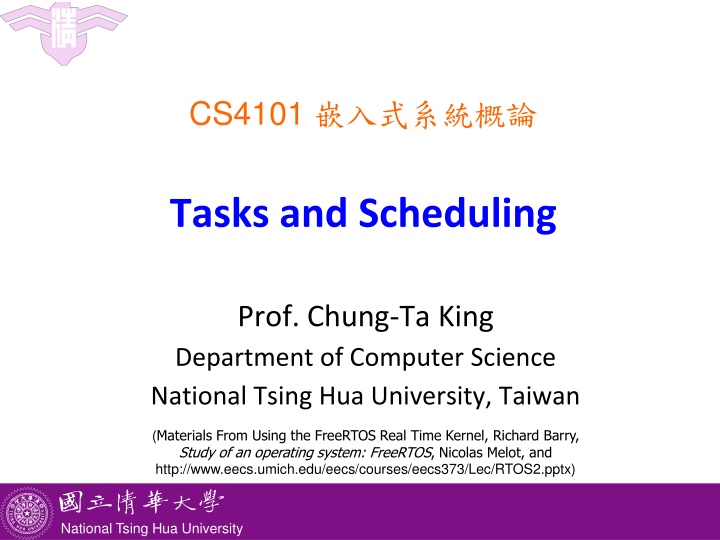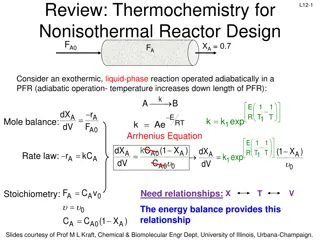
Understanding FreeRTOS Task Management
Explore the fundamentals of task management in FreeRTOS, covering task states, creation, scheduling, and more. Learn about the execution flow of tasks and their states like Running, Ready, Blocked, and Suspended. Dive into task creation, priority settings, and resource allocation within FreeRTOS.
Download Presentation

Please find below an Image/Link to download the presentation.
The content on the website is provided AS IS for your information and personal use only. It may not be sold, licensed, or shared on other websites without obtaining consent from the author. If you encounter any issues during the download, it is possible that the publisher has removed the file from their server.
You are allowed to download the files provided on this website for personal or commercial use, subject to the condition that they are used lawfully. All files are the property of their respective owners.
The content on the website is provided AS IS for your information and personal use only. It may not be sold, licensed, or shared on other websites without obtaining consent from the author.
E N D
Presentation Transcript
CS4101 Tasks and Scheduling Prof. Chung-Ta King Department of Computer Science National Tsing Hua University, Taiwan (Materials From Using the FreeRTOS Real Time Kernel, Richard Barry, Study of an operating system: FreeRTOS, Nicolas Melot, and http://www.eecs.umich.edu/eecs/courses/eecs373/Lec/RTOS2.pptx) National Tsing Hua University
Outline Tasks in FreeRTOS Task states Task creation and deletion Task scheduler of FreeRTOS Priority and ticks Delaying a task Suspending and resuming a task Idle task hook Changing priority 1 National Tsing Hua University
Tasks in FreeRTOS In FreeRTOS, computations are organized around tasks, which are the most basic unit of scheduling A task is a thread A task is a function that must return void and take a void pointer parameter: void ATaskFunction(void *pvParameters); A task normally runs in an infinite loop and must not return You inform the scheduler of The task s resource needs (stack space, priority) Any arguments the task needs National Tsing Hua University
Task States in FreeRTOS Running: Task is actually executing Only one task can exist in Running state at any one time (assuming 1-core system) Ready: Task is ready to execute but a task of equal or higher priority is Running 3 National Tsing Hua University
Task States in FreeRTOS Blocked: Task is waiting for some event Time: if a task calls vTaskDelay() it will be blocked until the delay period has expired Resource: tasks can also block waiting for queue and semaphore events Suspended: Much like blocked, but not waiting for anything Tasks will only enter or exit the suspended state when explicitly commanded to do so through the vTaskSuspend() and vTaskResume() API calls respectively 4 National Tsing Hua University
Task Creation xTaskCreate(pvTaskCode, pcName, usStackDepth, pvParameters, uxPriority, pxCreatedTask) pvTaskCode: pointer to task entry function, implemented to never return pcName: a descriptive name for the task to facilitate debugging usStackDepth: size of task stack, specified as the number of variables that the stack can hold pvParameters: pointer to parameters for the task uxPriority: priority at which the task should run; low numeric priority values denote low priority pvCreatedTask: pass back a handle to reference the task 5 National Tsing Hua University
Task Deletion A created task commonly runs in an infinite loop, but it may invoke vTaskDestroy(NULL) to end void vTaskDelete(TaskHandle_t xTask); xTask: handle of the task to be deleted; NULL to cause the calling task to be deleted Remove a task from the RTOS kernels management void vOtherFunction(void) { TaskHandle_t xHandle = NULL; // Create the task, storing the handle. xTaskCreate(vTaskCode, "NAME", STACK_SIZE, NULL, tskIDLE_PRIORITY, &xHandle); // Use the handle to delete the task. if(xHandle != NULL) vTaskDelete(xHandle); } 6 National Tsing Hua University
Outline Tasks in FreeRTOS Task states Task creation and deletion Task scheduler of FreeRTOS Priority and ticks Delaying a task Suspending and resuming a task Idle task hook Changing priority 7 National Tsing Hua University
Scheduler of FreeRTOS Task scheduling: decide which task in Ready state has to be run at a given time RTOS scheduler is started by calling void vTaskStartScheduler(void); RTOS kernel now has control over which tasks are executed and when (Arduino invokes it automatically) An Idle task is automatically created by scheduler when vTaskStartScheduler() is called Because CPU always needs something to execute must always be one task that can enter Running state The idle task has lowest priority (priority 0) to never prevent a higher priority task from running 8 National Tsing Hua University
Task Priority FreeRTOS only uses the priorities of tasks to decide which task to run next The uxPriority parameter of xTaskCreate() assigns an initial priority to the task being created Can be changed using vTaskPrioritySet() Low numeric priority values denote low priority tasks Scheduler always selects the highest priority task that is able to run When more than one task of the same priority is able to run, the scheduler uses round-robin 9 National Tsing Hua University
Ticks To select the next task to run, the scheduler has to be executed periodically By a periodic interrupt called the tick interrupt FreeRTOS API calls always specify time in tick interrupts (or just ticks ) Tick count is the total number of tick interrupts that have occurred since the scheduler was started 10 National Tsing Hua University
Sample Code for Task Priority static const char *pcTextForTask1 = T1 running\r\n ; static const char *pcTextForTask2 = T2 running\t\n ; int main(void) { /* Create the first task at priority 1. */ xTaskCreate(vTaskFunction, "Task 1", 1000, (void*)pcTextForTask1, 1, NULL); /* Create the second task at priority 2. */ xTaskCreate(vTaskFunction, "Task 2", 1000, (void*)pcTextForTask2, 2, NULL); /* Start scheduler so the tasks start executing. */ vTaskStartScheduler(); return 0; } 11 National Tsing Hua University
Running Multiple Periodic Tasks It is inconvenient to run multiple periodic jobs using a single Arduino loop, e.g. Measure the light using the photoresistor at 1 Hz Measure the sound intensity using microphone at 2.5 Hz Measure the distance of an object using the ultrasonic sensor at 0.4 Hz Even if we run each job in a FreeRTOS task, we still need a way to schedule the tasks at specified time Use blocked state with vTaskDelay() 12 National Tsing Hua University
Delaying a Task void vTaskDelay(const TickType_t xTicksToDelay) Places the calling task into the Blocked state for a fixed number of tick interrupts While in the Blocked state, the task will not use any processing time equivalent to timer interrupt Note: Frequency of the periodic task depends on the path of the code, as well as other tasks and interrupt activities void vTaskFunction(void * pvParameters) { const TickType_t xDelay = 500/portTICK_PERIOD_MS; for( ;; ) { vToggleLED(); vTaskDelay(xDelay); /* Block for 500ms. */ } } 13 National Tsing Hua University
Delaying a Task void vTaskDelayUntil(TickType_t *pxPreviousWakeTime, const TickType_t xTimeIncrement); Delay a task until a specified time to ensure a constant execution frequency vTaskDelay() specifies a time at which the task wishes to unblock relative to the time at which vTaskDelay() is called vTaskDelayUntil() specifies an absolute time to unblock the task pxPreviousWakeTime: the time that task last left Blocked state This time is used as a reference point to calculate the time at which the task should next leave the Blocked state xTimeIncrement: frequency of the periodic task in ticks vTaskDelayUntil() will return immediately without blocking if the specified wake time is already in the past 14 National Tsing Hua University
Sample Code for Periodic Tasks void vTaskFunction(void * pvParameters){ // Perform an action every 10 ticks TickType_t xLastWakeTime; const TickType_t xFrequency = 10; // Initialize the xLastWakeTime variable with the current time. xLastWakeTime = xTaskGetTickCount(); for( ;; ) { // Wait for the next period. vTaskDelayUntil(&xLastWakeTime, xFrequency); // Perform action here. } } 15 National Tsing Hua University
Suspending and Resuming a Task void vTaskSuspend(TaskHandle_t xTaskToSuspend) Suspend any task Task will never get any microcontroller processing time, no matter what its priority Calls to vTaskSuspend() are not accumulative, i.e. calling vTaskSuspend () twice on the same task still only requires one call to vTaskResume () to ready the suspended task void vTaskResume(TaskHandle_t xTaskToResume) Resumes a suspended task A task that has been suspended by one or more calls to vTaskSuspend () will be made available for running again by a single call to vTaskResume () 16 National Tsing Hua University
Sample Code for Suspending a Task void vAFunction(void) { TaskHandle_t xHandle; // Create a task, storing the handle. xTaskCreate(vTaskCode, "NAME", STACK_SIZE, NULL, tskIDLE_PRIORITY, &xHandle); // ... // Use the handle to suspend the created task vTaskSuspend(xHandle); // ... // Created task will not run during this period // ... // Resume the suspended task ourselves. vTaskResume(xHandle); } 17 National Tsing Hua University
Idle Task Hook Recall: An Idle task is created when vTaskStartScheduler() is called so that there is at least always a task to run Can add special functionality into the idle task through an idle hook (or call-back) function void vApplicationIdleHook(void); A function that is automatically called by the idle task once per iteration of the idle task loop Common uses for the Idle task hook include: Executing low priority, background or continuous task Measuring the amount of spare processing capacity Placing the processor into a low power mode 18 National Tsing Hua University
Changing the Priority of a Task void vTaskPrioritySet(TaskHandle_t pxTask, UBaseType_t uxNewPriority); Set the priority of any task pxTask: handle of the task whose priority is being modified (NULL for itself) uxNewPriority: the priority to which the task is to be set Capped to the maximum available priority of (configMAX_PRIORITIES 1), where configMAX_PRIORITIES is a compile time option set in the FreeRTOSConfig.h header file A context switch will occur before the function returns if the priority being set is higher than the currently executing task unsigned portBASE_TYPE uxTaskPriorityGet(xTaskHandle pxTask); 19 National Tsing Hua University
Sample Code for Changing Priority void vTask1(void *pvParameters) { unsigned portBASE_TYPE uxPriority; uxPriority = uxTaskPriorityGet(NULL); // my priority for( ;; ) { vPrintString( Task1 raises Task2 s priority\r\n" ); vTaskPrioritySet(xTask2Handle, (uxPriority + 1)); /* For Task1 to reach this point Task2 must set its priority back down to below Task1. */ } } void vTask2(void *pvParameters) { unsigned portBASE_TYPE uxPriority; uxPriority = uxTaskPriorityGet(NULL); for( ;; ) { vPrintString( Task2 lower its priority\r\n"); vTaskPrioritySet(NULL, (uxPriority - 2)); } } 20 National Tsing Hua University
Sample Code for Changing Priority xTaskHandle xTask2Handle; int main(void) { // Create Task1 at priority 2 xTaskCreate(vTask1, "Task 1", 1000, NULL, 2, NULL); // Create Task2 at priority 1 xTaskCreate(vTask2, "Task 2", 1000, NULL, 1, &xTask2Handle); // Start the scheduler vTaskStartScheduler(); /* If all is well, then main() will never reach here as the scheduler will now be running the tasks. If main() does reach here, then it is likely that there was insufficient heap memory available for the idle task to be created.*/ for( ;; ); } 21 National Tsing Hua University
Summary FreeRTOS runs Fixed Priority Preemptive Scheduling Each task is assigned a priority Each task can exist in one of several states Only one task can exist in Running state at any one time The scheduler will always select the highest priority Ready state task to enter the Running state Scheduling is made at each tick interrupt 22 National Tsing Hua University

